Lady Stheno
Stheno in ancient lore was the elder sister of the Gorgons, but you can see we portray her awful reality very differently from the bowdlerized Greek version. Like her namesake (or perhaps the namesake is a reflection of the reality) she can petrify her victims.
Her menace is simply her attack, like Baphomet. But her attack is not that amazing – a feeble 6d8 – as weak as Baphomet once his Wall is KOed. In addition, at least at first, her attack BENEFITs her target – each die that misses (by rolling too low) increases the victim’s toughness by 1! Her toughness is equal to her attacker’s toughness, which seems good at first, because most heroes only have a toughness of 1-3.
Battling Stheno
Stheno turns her victims to stone. Here’s how. After Stheno’s attack, her victim gains 1 Toughness for each of Stheno’s attack dice that missed, as previously stated. If your toughness reaches 12, you are turned to stone and that’s the end of you, regardless of remaining health.
Let’s look at an example. Cindrew fights Lady Stheno. The menace triggers, and Stheno attacks Cindrew. Let’s say Stheno rolls 1, 2, 3, 4, 6, & 6. (I just rolled 6d8 and those are my results.) Two of the results missed Cindrew (toughness 2), so she takes 4 damage, and increases her toughness by 2, to 4. At the end of that battle round, Stheno attacks again. Let’s say she attacks Cindrew a second time, and gets the exact same results (it’s only an example, after all). Now, three of Stheno’s results miss, and Cindrew’s toughness rises 3 more – to 7! If Cindrew sticks around for a third round, and Stheno hits her again, and again gets the same rolls, Cindrew’s toughness will increase by 6 to a total of 13!! But here is the dismal problem – when a player’s toughness reaches 12+, they are immediately fossilized, turn to stone, and die, regardless of how much health they have left. So with Stheno, you are not so much afraid of the damage she inflicts, as of the damage she DOESN’T inflict.
When you exit Stheno’s area, you “get” to lower your toughness by 1. This may sound good vs. Stheno, but remember not all the heroes may have been attacked by Stheno in the fight. Those heroes lose 1 toughness, too, making them weaker against other foes! This means that in most fights against Stheno, players try to stay at least 1 round per hero, so everyone gets a turn at being attacked, so the toughness loss isn’t too harsh. But this also means everyone is likely damaged. Of course, clever players can figure out ways to benefit from the increased toughness vs. minions, and an early dip into Stheno’s pool might be handy along these lines. But eventually the time will come to pay the piper.
Stheno also has a LOT of hit points – almost as many as the mighty Geryon. So she’s going to get a lot of hits in, petrifying heroes bit by bit. You need to decide if you are going to spread the wealth (so to speak) or focus all the death on one target.
Aftermath – Stheno
Most maps have a single normal lord (or lady) to face. But a few maps have multiple lords. In these cases, you could be fighting another lord after killing Stheno. But alas, when Stheno is banished, all heroes “unfossilize” and toughness returns to the hero’s starting toughness (plus any toughness-enhancing gifts). So you don’t actually benefit, long-term, from Stheno’s petrifying effect. However, you could hit Stheno first, then return to the map and go after the other lords with your new high toughness. Then return to Stheno later.
Lord Tarasque
The Tarasque is a legendary dragon-like monster that plagued medieval France. We have decided that the Tarasque was actually a demon, not a monster, and here it is. It’s a really tough enemy.
First off, the Tarasque’s menace simply sets every single hero on Fire. So far so good, because Fire markers don’t normally progress during Hell Time. But read on.
Second, the Tarasque has Toughness 6 (as tough as Baphomet!), and rolls 6d10 for its attack. However, when it attacks, it ALSO inflicts 1 damage on each hero who’s on Fire. Including the one the Tarasque is attacking.
Battling the Tarasque
You can give up your attack when fighting the Tarasque in order to discard a Fire marker on yourself or another hero. Of course giving up an attack isn’t lightly done, but there is another reason you may not want to do this – each time a hero is damaged due to Fire in this battle, he gains 1 Courage. So if you let yourself burn, each time the Tarasque attacks you’ll get 1 Courage (as well as take 1 damage). The best use of this Courage is to help other heroes who are trying to kill the Tarasque of course.
The Tarasque’s Spines ability sets up your next real problem. If you inflict 2 or more damage on the Tarasque, then YOU take 1 damage. You are allowed to voluntarily lower the damage you inflict to avoid this but that opens up another can of worms.
Because of the Fire and the spines, heroes tend to “burn down” really quickly fighting the Tarasque. You can’t usually bull your way through.

